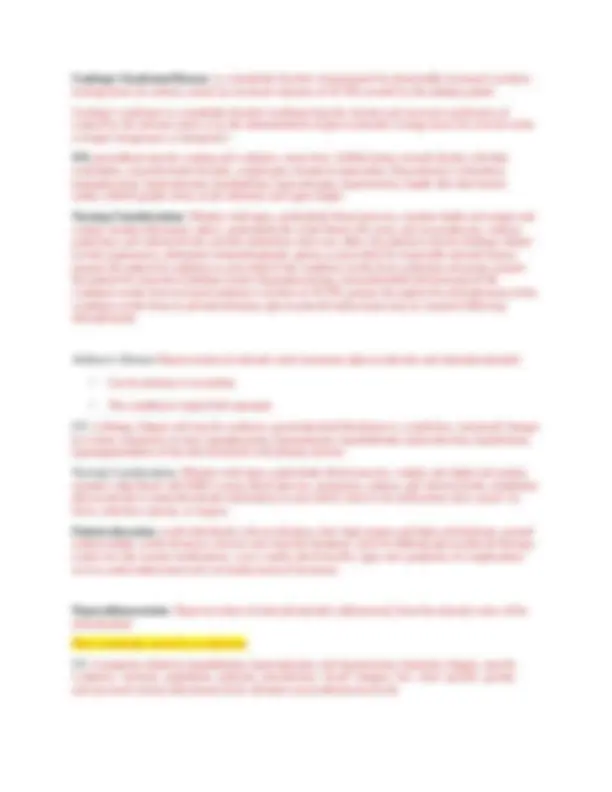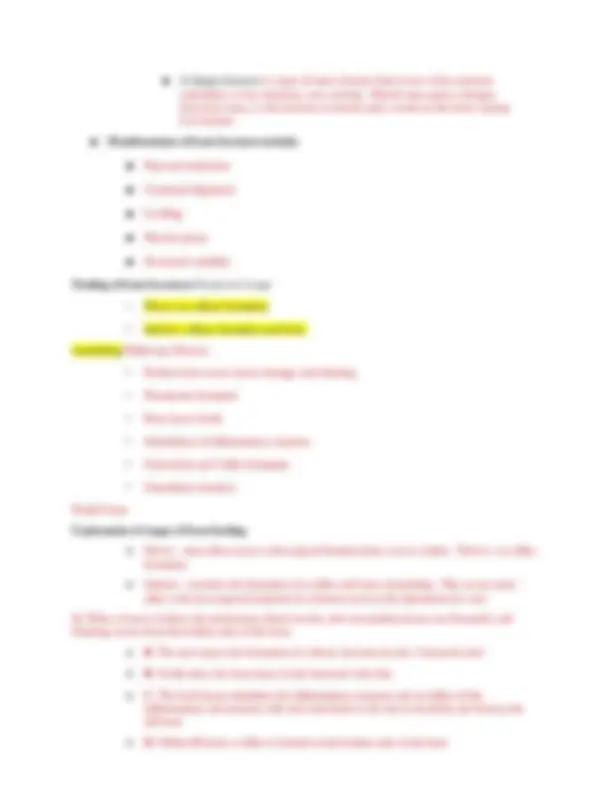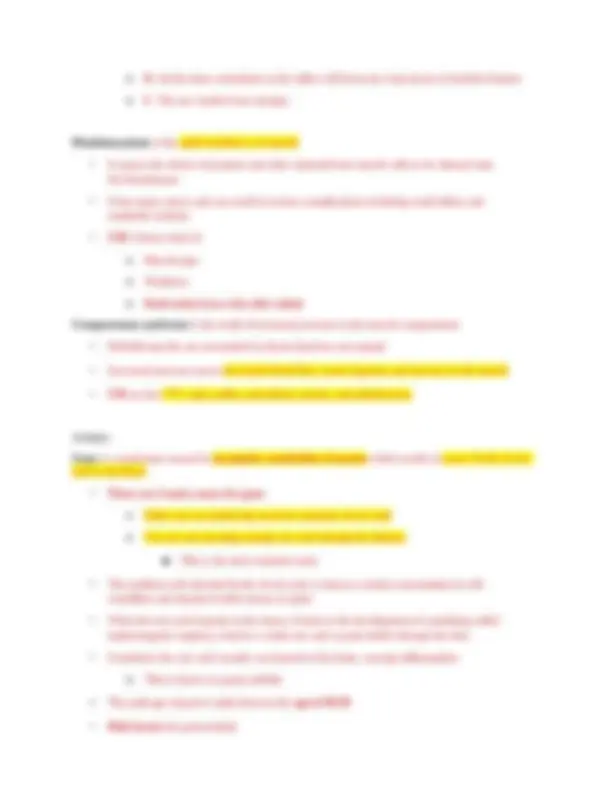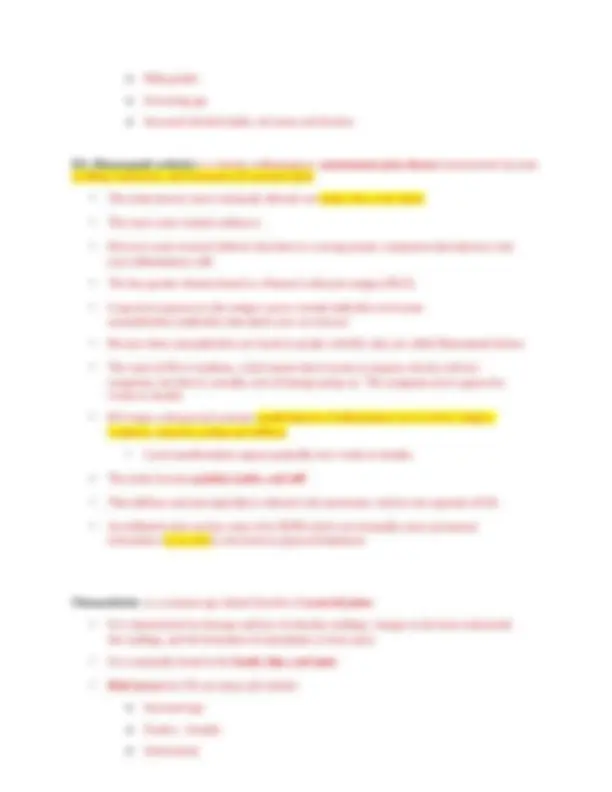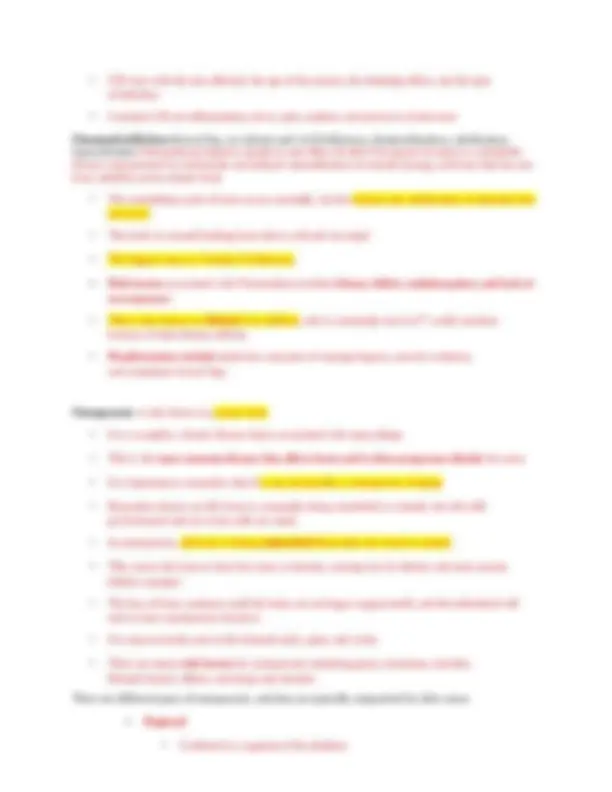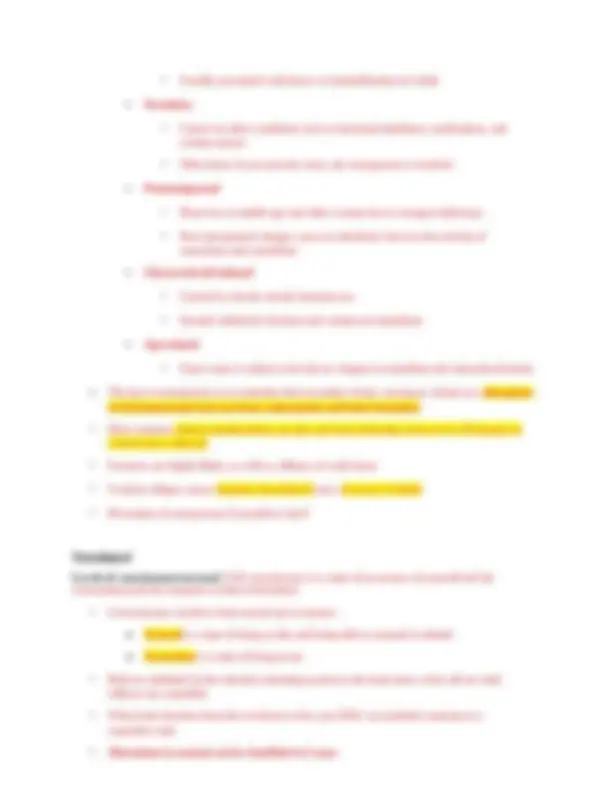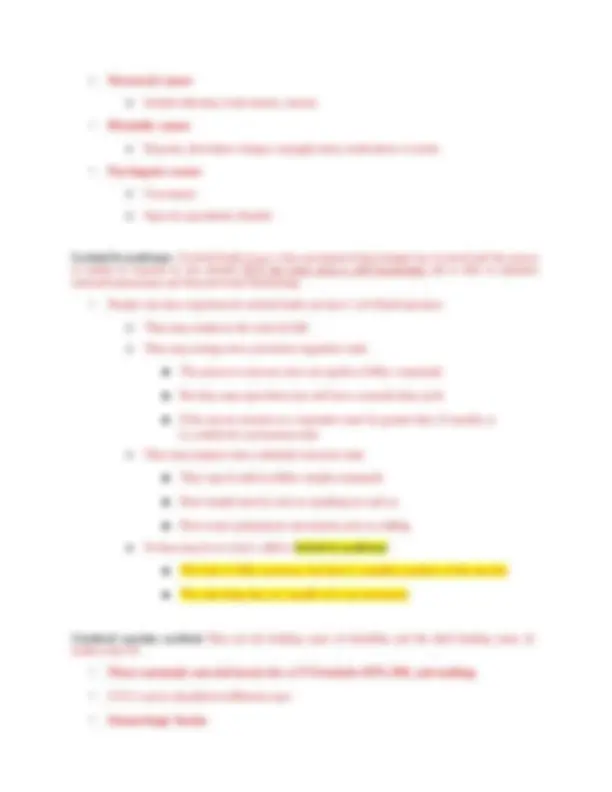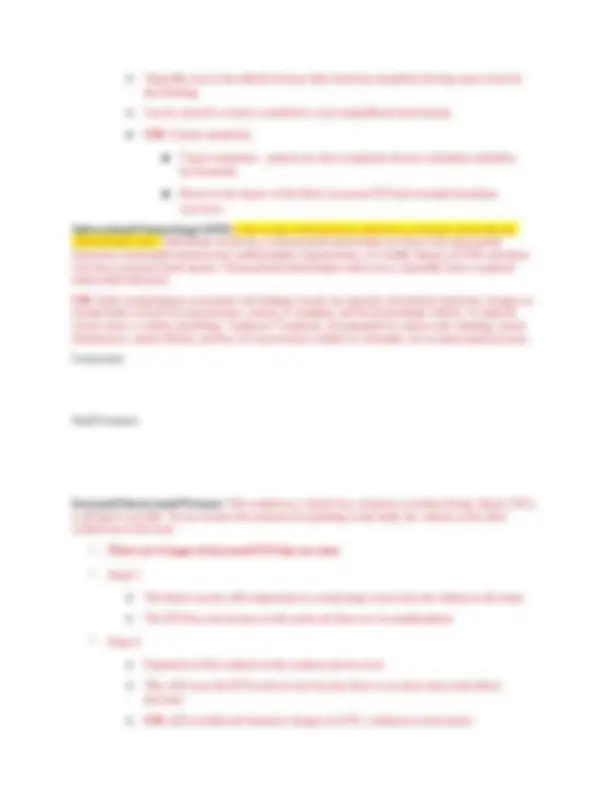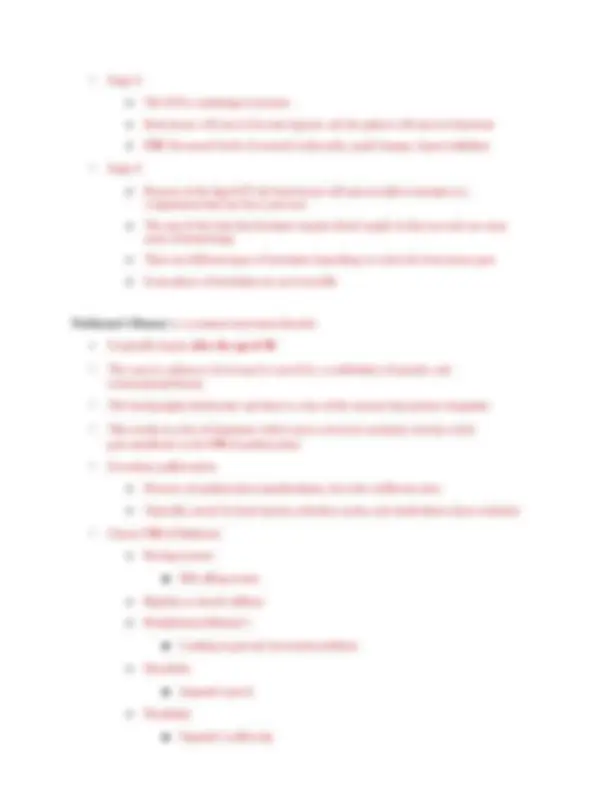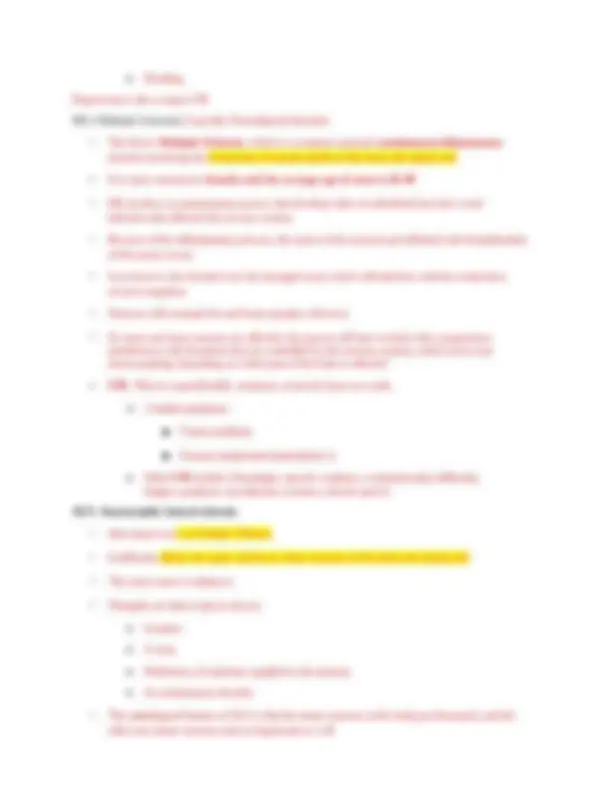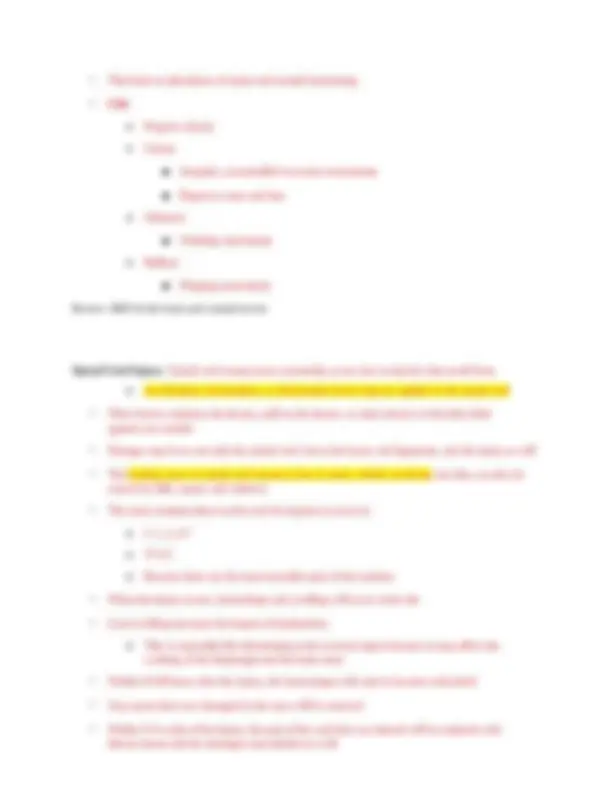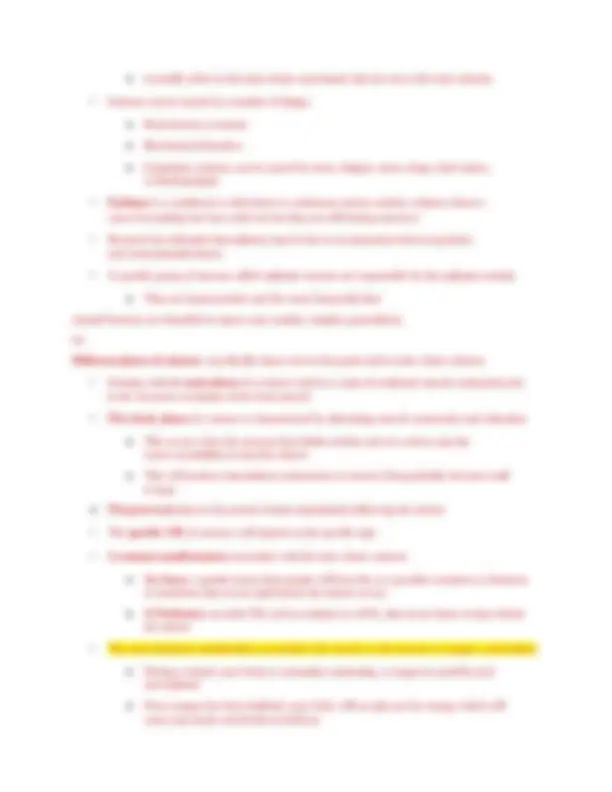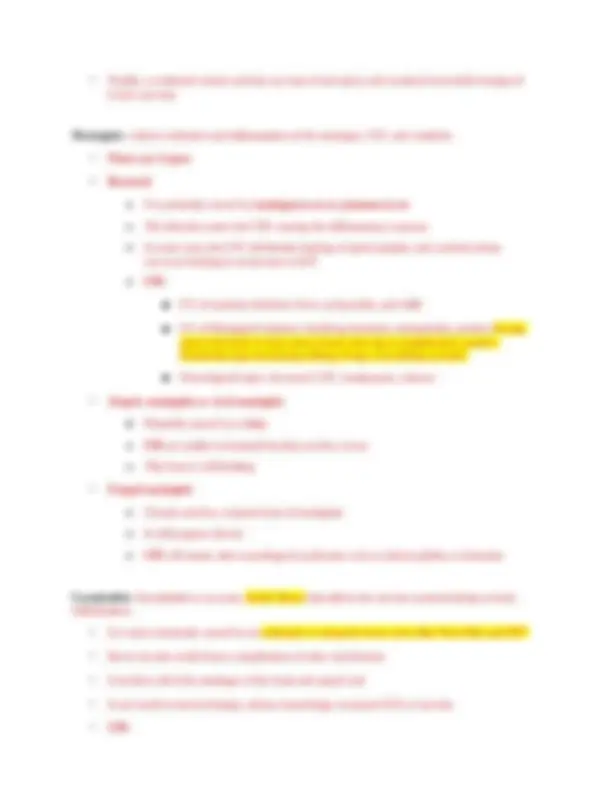Download NR 283 Pathophysiology Final Exam Concept Review and more Exams Pathophysiology in PDF only on Docsity!
NR 283 Pathophysiology Final Exam
Concept Review
***For all previous content covered on previous exams, please consult your previous concept review sheets. This is not an all-inclusive list for topics to be covered. Please be sure to consult your syllabus and learning plan. This is a comprehensive final. ***Be sure to cover pathophysiology, etiology, clinical manifestations, nursing considerations, diagnostic tests for the following topics: Endocrine SIADH- Syndrome of Inappropriate Diuretic Hormone Too much ADH (antidiuretic hormone ) secretion leads to water intoxication and hyponatremia Causes include trauma, stroke, malignancies (often in the lungs or pancreas), medications, and stress S/S include signs of fluid volume overload, changes in level of consciousness and mental status changes, weight gain, hypertension, tachycardia, anorexia, nausea, vomiting, hyponatremia, concentrated urine, decreased urine output, serum osmolality decreased Nursing considerations include monitoring vital signs and cardiac and neurological status, providing a safe environment, particularly for the patient with changes in level of consciousness or mental status, monitoring intake and output and weight daily; monitoring fluid and electrolyte balance, monitoring serum and urine osmolality; restriction of fluids DI (Diabetes Insipidus)- Kidney tubules fail to reabsorb water Etiology includes stroke or trauma or may be idiopathic S/S include excretion of large amounts of dilute urine, polydipsia, dehydration (decreased skin turgor and dry mucous membranes), inability to concentrate urine, increased urine output, urine very dilute, Low urinary specific gravity, fatigue, muscle pain and weakness, headache, postural hypotension that may progress to vascular collapse without rehydration, tachycardia, hypernatremia Nursing Considerations : monitor vital signs and neurological and cardiovascular status, provide a safe environment, particularly for the patient with postural hypotension; monitor electrolyte levels and for signs of dehydration; maintain patient intake of adequate fluids; monitor intake and ouput, weight, serum osmolality and specific gravity of urine; instruct the patient to avoid foods and/or liquids that produce diuresis Hyperthyroidism - Too much thyroid hormone (T3 and T4) Characterized by an increased rate of body metabolism Common cause is Graves’ disease, also known as toxic diffuse goiter S/S include : personality changes such as irritability, agitation and mood swings, nervousness and fine tremors of the hands, heat intolerance, weight loss, smooth, soft skin and hair, palpitations, cardiac dysrhythmias such as tachycardia or atrial fibrillation, diarrhea, protruding eyeballs (exophthalmos) may be present, diaphoresis (sweating), hypertension, enlarged thyroid gland (goiter)
Nursing Considerations : Provide adequate rest, provide a cool and quiet environment, provide a high- calorie diet, obtain daily weight, avoid administration of stimulants, administer sedatives as prescribed, administer antithyroid medications, administer blood pressure medication for tachycardia, prepare for thyroidectomy if prescribed Hypothyroidism - Hyposecretion of thyroid hormones (T3 and T4) Characterized by a decreased rate of body metabolism Causes : autoimmune disease, treatment for hyperthyroidism, radiation therapy, thyroid surgery, certain medications S/S: lethargy, fatigue, weakness, muscle aches, paresthesias, intolerance to cold, weight gain, dry skin and hair and loss of body hair, bradycardia, constipation, generalized puffiness and edema around the eyes and face (myxedema), forgetfulness and loss of memory, menstrual disturbances, cardiac enlargement, tendency to develop heart failure, goiter may or may not be present Hyperparathyroidism- Hypersecretion of parathyroid hormone (PTH) Causes: Tumor, Hyperplasia, Genetics; secondary causes-severe calcium or vitamin D deficiency, chronic kidney failure S/S: Hypercalcemia and hypophosphatemia, fatigue and muscle weakness, skeletal pain and tenderness, bone deformities that result in pathological fractures, anorexia, nausea, vomiting, epigastric pain, weight loss, constipation, hypertension, cardiac dysrhythmias, renal stones Nursing Considerations : Monitor vital signs, particularly blood pressure; monitor for cardiac dysrhythmias, monitor for intake and output and for signs of renal stones, monitor skeletal pain, move the patient slowly and carefully; encourage fluid intake, administer furosemide (Lasix) as prescribed to lower calcium levels, administer phosphates, which interfere with calcium reabsorption as prescribed, administer calcitonin as prescribed to decrease the skeletal calcium release and increase renal excretion of calcium, monitor calcium and phosphorus levels, prepare the patient for parathyroidectomy as prescribed Hypoparathyroidism - Hyposecretion of parathyroid hormone (PTH) Can occur following a thyroidectomy because of removal of parathyroid tissue S/S: Hypocalcemia and hyperphosphatemia, numbness and tingling in the face, muscle cramps and cramps in the abdomen or extremities, positive Trousseau’s and Chvostek’s sign, signs of overt tetany such as bronchospasm, laryngospasm, carpopedal spasm, dysphagia, photophobia, cardiac dysrhythmias, seizures; hypotension, anxiety, irritability, depression Nursing Considerations: Monitor vital signs, monitor for signs of hypocalcemia and tetany, initiate seizure precautions, place a tracheostomy set, oxygen and suctioning equipment at bedside, prepare to administer calcium gluconate intravenously for hypocalcemia, provide a high-calcium, low-phosphorus diet, instruct the patient on administration of calcium supplements as prescribed, instruct the patient on administration of vitamin D supplements as prescribed, vitamin D enhances the absorption of calcium from the GI tract, instruct the patient on administration of phosphate binders as prescribed to promote the excretion of phosphate through the gastrointestinal tract, instruct to wear a Medic-Alert bracelet
Nursing Considerations : Monitor vital signs, particulary blood pressure; monitor for signs of hypokalemia and hypernatremia; monitor intake and output and urine for specific gravity; Spironolactone (Aldactone) may be prescribed to promote fluid balance and control hypertension; this is a potassium- sparing diuretic and aldosterone antagonist, and patients need to be monitored for hyperkalemia, particularly those with impaired renal function or excessive potassium intake; administer potassium supplements as prescribed; prepare the patient for adrenalectomy; maintain sodium restriction, as prescribed, preoperatively; administer glucocorticoids preoperatively, as prescribed, to prevent adrenal hypofunction; monitor the patient for adrenal insufficiency postoperatively; instruct the patient regarding the need for glucocorticoid therapy following adrenalectomy; instruct the patient about the need to wear a Medic-Alert bracelet Pheochromocytoma - Catecholamine-producing tumor usually found in the adrenal medulla, but extra adrenal locations include the chest, bladder, abdomen, and brain; typically is benign tumor but can be malignant Excessive epinephrine and norepinephrine secreted S/S: paroxysmal or sustained hypertension, severe headaches, palpitations, flushing and profuse diaphoresis, pain in the chest or abdomen with nausea and vomiting, heat intolerance, weight loss, tremors Complications: hypertensive crisis, hypertensive retinopathy and nephropathy, cardiac enlargement, dysrhythmias, heart failure, myocardial infarction, increased platelet aggregation, and stroke; death can occur from shock, stroke, renal failure, dysrhythmias, or dissecting aortic aneurysm Nursing Considerations : Monitor vital signs particularly blood pressure and heart rate; monitor for hypertensive crisis; monitor for complications that can occur with hypertensive crisis, such as stroke, cardiac dysrhythmias, myocardial infarction; prepare to administer antihypertensive agents to control hypertension; monitor serum glucose level; promote rest and a nonstressful environment; provide diet high in calories, vitamins, and minerals; prepare for an adrenalectomy It is important to avoid stimuli that can precipitate a hypertensive crisis, such as increased abdominal pressure and vigorous abdominal palpation Diabetes Mellitus (DM)- A group of diseases characterized by hyperglycemia due to defects in insulin secretion, insulin action, or both Normally, a certain amount of glucose circulates in the blood. Major sources of glucose are absorption of ingested food in the GI tract and formation of glucose by the liver from food substances Diabetes is especially prevalent in the elderly ; as many as 50% of people older than 65 years of age has some degree of glucose intolerance. People 65 years and older account for almost 40% of people with diabetes. Risk Factors ● Family history ● Obesity
● Race/ethnicity- (African Americans, Hispanics, Native Americans, Asian Americans, Pacific Islanders) ● Age- greater than or equal to 45 years old ● Impaired fasting glucose or impaired glucose tolerance ● Hypertension ● HDL/Triglyceride level- HDL less than or equal to 35 and or triglyceride level greater than or equal to 250 ● History of gestational diabetes or delivery of babies over 9 lbs 7 tips for managing diabetes ● Healthy eating ● Being active ● Monitoring ● Taking medication ● Problem solving ● Healthy coping ● Reducing risks Patho- ● Insulin secreted by beta cells ● Insulin levels increase after meals consumed ● During fasting periods insulin and glucagon is released ● Liver produces glucose through ● Glycogenolysis – the breakdown of glycogen to glucose which occurs in the liver & muscles ● Glyconeogenesis- the making of glucagon Prediabetes is classified as impaired glucose tolerance (IGT) or impaired fasting glucose (IFG) and refers to a condition in which blood glucose concentrations fall between normal levels and those considered diagnostic for diabetes Type I Diabetes -(genetics/juvenile) Insulin producing beta cells in the pancreas are destroyed by an autoimmune process, genetic susceptibility, or environmental factors ● Requires insulin, as little or no insulin is produced ● Onset is acute and usually before 30 years of age ● 5–10% of persons with diabetes
Musculoskeletal Sprains/Strains - A sprain is a tear or injury to a ligament
- A strain is a tear or injury to a tendon
- An avulsion is a complete separation of a tendon or ligament from its bony attachment site
- Dislocation is the complete loss of contact between 2 bones in a joint
- Subluxation is a partial loss of contact
- They are typically associated with bone fractures, most commonly the fingers and shoulder
- However they can also be associated with other musculoskeletal disorders that affect the stability of muscles, bones, or joints. Fractures- A fracture is a break in the continuity of bone
- Fractures are classified in many ways:
- A complete fracture is when the bone is broken entirely: o Open – when the skin is broken and the bone pushes through o Closed – when the bone does not push through the skin, the skin remains intact o Comminuted – the bone has been broken into 2 or more fragments o Linear – the bone has been broken at a parallel to the long axis of the bone o Oblique – the bone has been fractured at an angle to the long axis o Spiral – the bone has a fracture that encircles the entire bone o Transverse – the bone has a fracture perpendicular to the long axis o Impacted – the bone has been fractured and the 2 parts get pushed together o Pathologic – the bone has fractured at a part of bone that has been weakened by an illness, such as osteoporosis
- An incomplete fracture is when the bone is damaged but remains in 1 piece: o Greenstick – part of the outer portion of the bone splinters, but the inner part of the bone remains intact o Torus – the bone buckles out but does not break o Bowing – typically occurs in bones that are paired (radius and ulna) where one of the bones break, but the other bone bows out instead of breaking o Stress – small fractures that occur in bone that is subjected to repeated strain, like athletes. The key with stress fractures is that over time, repeated stress fractures to the same area will eventually cause a complete fracture of that bone
▪ A fatigue fracture is a type of stress fracture that occurs when someone undertakes a very strenuous, new activity. Muscle mass grows stronger than bone mass, so the increase in muscle puts a strain on the bone causing it to fracture ▪ Manifestations of bone fractures include : ▪ Pain and tenderness ▪ Unnatural alignment ▪ Swelling ▪ Muscle spasm ▪ Decreased mobility Healing of bone fractures- Occurs in 2 ways:
- Direct: no callous formation
- Indirect: callous formation and bone remodeling Multi-step Process:
- Broken bone causes tissue damage and bleeding
- Hematoma formation
- Bone tissue death
- Stimulation of inflammatory response
- Osteoclasts and Callus formation
- Osteoblasts function Healed bone Explanation of stages of bone healing o Direct – most often occurs with surgical fixation (pins, screws, bolts). There is no callus formation o Indirect – involves the formation of a callus and bone remodeling. This occurs most often with non-surgical treatment of a fracture such as the placement of a cast A. When a bone is broken, the periosteum, blood vessels, and surrounding tissues are disrupted, and bleeding occurs from the broken ends of the bone o B. The next step is the formation of a blood clot between the 2 fractured ends o B. At this time, the bone tissue in the fractured ends dies o C. The dead tissue stimulates the inflammatory response and an influx of the inflammatory and immune cells and osteoclasts to the site to decalcify and destroy the old bone o D. Within 48 hours a callus is formed on the broken ends of the bone
o Male gender o Increasing age o Increased alcohol intake, red meat, and fructose RA -Rheumatoid arthritis is a chronic, inflammatory, autoimmune joint disease characterized by joint swelling, tenderness, and destruction of synovial joints
- The joints that are most commonly affected are hands, feet, wrist, knees
- The exact cause remains unknown
- However some research believes that there is a strong genetic component that interacts with your inflammatory cells
- The key genetic element found is a Human Leukocyte antigen (HLA)
- Long term exposure to this antigen causes normal antibodies to become autoantibodies (antibodies that attach your own tissue)
- Because these autoantibodies are found in people with RA, they are called Rheumatoid factors
- The onset of RA is insidious, which means that it seems to progress slowly with few symptoms, but there is actually a lot of damage going on. The symptoms don’t appear for weeks to months
- RA begins with general systemic manifestations of inflammation such as fever, fatigue, weakness, anorexia, aching and stiffness - Local manifestations appear gradually over weeks to months. - The joints become painful, tender, and stiff
- That stiffness and pain typically is relieved with movement, which is the opposite of OA
- An inflamed joint can lose some of its ROM which can eventually cause permanent deformities (swan neck) which lead to physical limitations Osteoarthritis - is a common age related disorder of synovial joints
- It is characterized by damage and loss of articular cartilage, changes in the bone underneath the cartilage, and the formation of osteophytes or bone spurs
- It is commonly found in the hands, hips, and spine
- Risk factors for OA are many and include: o Increased age o Gender – females o Joint trauma
o Obesity o Certain medications The exact cause of osteoarthritis is unknown, but we do know what happens The primary defect of OA is the damage and loss of articular cartilage
- The surface of the cartilage becomes rough and worn, which interferes with easy joint movement
- Eventually enough of the cartilage is destroyed, causing exposure of the bone
- Next, osteophytes or bone spurs start to grow off of the exposed bone
- Pieces of these osteophytes break off into the joint cavity, causing further irritation and joint movement interference
- Eventually the joint space becomes narrow
- Secondary inflammation of the surrounding tissue can also occur in response to the changes in joint movement
- Manifestations:
- The first and most prominent symptom is pain in one or more joints when the joint is being used
- Joint stiffness, swelling, and limited ROM
- Heberden and Bouchard nodules may be present as well o They are actually signs of the osteophytes in the joint cavities o Heberden are the ones in the joint closest to the fingernail Bouchard are the ones in the middle joint of the finger Ankylosing Spondylitis-(hunch back) is a chronic inflammatory joint disease characterized by stiffening and fusion of the spine and sacroiliac joints
- It is similar to RA in the sense that AS is an autoimmune disease
- The cause for AS is also not known, however there are strong thoughts that it may be related to the same Human Leukocyte Antigen (HLA) that is seen in patients with RA
- AS is mainly found in men between the age of 15-40, but it can affect any age men and women as well
- Pathophysiology:
- AS begins with inflammation of the fibrocartilage in cartilaginous joints
- Typically the sacroiliac joint is affected first
- Inflammatory cells infiltrate the area and breakdown the cartilage
- CM vary with the area affected, the age of the person, the initiating effect, and the type of infection
- Common CM are inflammation, fever, pain, malaise, and presence of abscesses Osteomalcia/Rickets -(bowed leg, no calcium and vit D deficiency, demineralization, calcification, hypocalcimia) Osteomalacia( happens mostly in men 46yrs & older Europeans decants) is a metabolic disease characterized by inadequate and delayed mineralization of osteoid (young, soft bone that has not been calcified yet) in mature bone
- The remodeling cycle of bone occurs normally, but the deposit and calcification of minerals does not occur
- This leads to normal looking bone that is soft and non-rigid
- The biggest cause is Vitamin D deficiency - Risk factors associated with Osteomalacia include dietary deficit, malabsorption, and lack of sun exposure
- This is also known as Rickets’s in children, and is commonly seen in 3 rd^ world countries because of their dietary deficits
- Manifestations include tenderness and pain of varying degrees, muscle weakness, and sometimes bowed legs Osteoporosis - is also known as porous bone
- It is a complex, chronic disease that is associated with many things
- This is the most common disease that affects bone and it often progresses silently for years
- It is important to remember that It is not necessarily a consequence of aging
- Remember that in our life bone is constantly being remodeled or remade; the old cells get destroyed and new bone cells are made
- In osteoporosis, old bone is being reabsorbed faster than new bone is created
- This causes the bone to have less mass or density, causing it to be thinner and more porous (think a sponge)
- The loss of bone continues until the body can no longer support itself, and the individual will start to have spontaneous fractures
- It is most severely seen in the femoral neck, spine, and wrists
- There are many risk factors for osteoporosis including genes, hormones, bad diet, lifestyle factors, illness, and drugs and steroids. There are different types of osteoporosis, and they are typically categorized by their cause: - Regional
- Confined to a segment of the skeleton
- Usually associated with disuse or immobilization of a limb - Secondary
- Causes by other conditions such as hormonal imbalance, medications, and certain cancers
- Often times if you treat the cause, the osteoporosis is resolved - Postmenopausal
- Bone loss in middle age and older woman due to estrogen deficiency
- Post-menopausal changes cause an imbalance between the activity of osteoclasts and osteoblasts - Glucocorticoid induced
- Caused by chronic steroid hormone use
- Steroids inhibit the function and creation of osteoblasts - Age related
- Exact cause is unknown but due to changes in osteoblast and osteoclast function - The key to osteoporosis is to remember that no matter what is causing it, it leads to a disruption of the homeostasis between bone reabsorption and bone formation
- Most common clinical manifestations are pain and bone deformity, however it will depend on which bone is affected
- Fractures are highly likely, as well as collapse of weak bones
- Vertical collapse causes kyphosis (hunchback) and a decrease in height
- Prevention of osteoporosis if possible is key‼ Neurological Levels of consciousness/arousal- Full consciousness is a state of awareness of yourself and the environment and the responses to that environment
- Consciousness involves both arousal and awareness: o Arousal is a state of being awake and being able to respond to stimuli o Awareness is a state of being aware
- Both are mediated by the reticular activating system in the brain stem, where all our vital reflexes are controlled.
- When brain function from the cerebrum is lost, your RAS can maintain someone in a vegetative state
- Alterations in arousal can be classified in 3 ways:
- It is typically caused by chronic HTN problems, but can also be caused by ruptured aneurysms, bleeding tumors, or bleeding from a head trauma
- The hemorrhage can be tiny or massive
- As bleeding continues into the brain tissue, a mass of blood is formed
- Brain tissue that is next to the bleeding area can become deformed, compressed, or displaced
- This will produce edema, increased ICP, and ischemia of brain tissue
- The hemorrhage will eventually resolve through reabsorption, and will leave a cavity in the brain where it was
- CM : vary depending on what part of the brain is affected
- A thrombotic CVA:
- An occlusion of one of the arteries of the brain
- Most commonly this is caused by atherosclerosis
- The CVA occurs when parts of the clot detach, travel upstream, and obstruct blood flow causing ischemia
- An embolic CVA :
- This is caused by a piece of plaque that has broken off of a clot that is elsewhere in the body, beyond the brain
- People who have embolic CVA’s are at a higher risk for developing more because the cause is still there (such as atherosclerosis of the heart)
- A TIA
- Is a brief episode of neurologic dysfunction due to platelet clumps or a partial obstruction
- People who have TIA’s are at a higher risk for developing a CVA Traumatic Brain Injury - A major head trauma is a traumatic insult to the brain that is capable of producing many changes to an individual, including physical, emotional, social, and intellectual
- Major head traumas can be caused by car accidents, falls, sports injuries, or violence
- There are 2 main types of head trauma’s: o Closed ▪ When the head strikes a hard surface (wall) or an object hits the head (baseball), and the skull and meninges remain intact ▪ These are the most common o Open
▪ Commonly caused by severe accidents or bullets ▪ The skull is broken and the brain gets exposed to the environment
- Brain damage from trauma can be categorized as: o Focal : affecting one area of the brain o Diffuse : affecting more than one area of the brain Hematomas-epidural/subdural/subarachnoid Extradural/Epidural hematoma/hemorrhage o Usually the result of a skull fracture that has tore an artery!!!! (Arterial bleed!, not venous) o Because arteries have a higher amount of pressure than veins do, the blood will accumulate quickly in the epidural space o The individual will lose consciousness at the time of the injury, but regain it for a period of time o This type of hematoma can be very deceiving, because the patient will feel okay, but the bleed is still occurring and is starting to accumulate o Eventually when the bleed grows big enough, the person will develop a worsening headache, vomiting, confusion, and seizures o Soon the brain will herniate, LOC will be lost, and the person may die o Epidural hematomas are considered medical emergencies Intracerebral hematomas Bleeding in the brain o Common in the frontal and temporal lobe o It can cause increased ICP, Decreased LOC, pupil and respiratory changes The third type of bleed caused by a focal injury is a subdural hematoma
- It is bleeding between the dura and the brain, usually associated with a torn vein
- **Subdural’s can be classified as:
- Acute:** o Develop rapidly with CM of headache, and some type of neurological change o CM will worsen over time and quickly progress to loss of consciousness, respiratory changes, and pupillary changes and brain herniation
- Chronic o Develop over weeks to months
- Stage 3 o The ICP is continuing to increase o Brain tissue will start to become hypoxic and the patient will start to deteriorate o CM : Decreased levels of arousal, bradycardia, pupil changes, hyperventilation
- Stage 4 o Because of the high ICP, the brain tissue will start to shift or herniate to a compartment that has lower pressure o The part of the brain that herniates impairs blood supply to that area and can cause areas of hemorrhage o There are different types of herniation depending on where the brain tissue goes o Some places of herniation are not reversible Parkinson’s Disease- is a common movement disorder - It typically begins after the age of 40
- The cause is unknown, but it may be caused by a combination of genetics and environmental factors
- The basal ganglia deteriorates and there is a loss of the neurons that produce dopamine
- This results in a loss of dopamine which causes excessive excitatory activity which gets manifested as the CM of parkinsonism
- Secondary parkinsonism o Presence of parkinsonism manifestations, but with a different cause o Typically caused by head injuries, infection, toxins, and medications (most common)
- Classic CM of Parkinson: o Resting tremors ▪ Pill rolling tremor o Rigidity or muscle stiffness o Bradykinesia/Akinesia’s ▪ Leading to gait and movement problems o Dysarthria ▪ Impaired speech o Dysphagia ▪ Impaired swallowing
o Drooling Depression is also a major CM MS-( Multiple Sclerosis) 3 specific Neurological disorders
- The first is Multiple Sclerosis , which is a common acquired autoimmune inflammatory disorder involving the destruction of axonal myelin in the brain and spinal cord - It is more common in females and the average age of onset is 20- 40
- MS involves an autoimmune process that develops after an individual has had a viral infection that affected the nervous system
- Because of the inflammatory process, the axons of the neurons get inflamed and demyelination of the axons occurs
- Scar tissue is also formed over the damaged axon which will interfere with the conduction of nerve impulses
- Neurons will eventual die and brain atrophy will occur
- As more and more neurons are affected, the person will have to deal with a progressive interference with functions that are controlled by the nervous system, which can be just about anything depending on which part of the brain is affected - CM: May be unpredictable, transient, or last for hours to weeks o 2 initial symptoms: ▪ Vision problems ▪ Sensory impairment (paresthesia’s) o Other CM include: Dysphagia, muscle weakness, communication difficulty, fatigue, paralysis, incontinence, tremors, slurred speech. ALS- Amyotrophic lateral sclerosis
- Also known as Lou Gehrig’s Disease
- It diffusely affects the upper and lower motor neurons of the brain and spinal cord
- The exact cause is unknown
- Thoughts are that it may be due to: o Genetics o A virus o Deficiency of nutrients supplied to the neurons o An autoimmune disorder
- The pathological feature of ALS is that the motor neurons in the body get destroyed, and the other non-motor neurons start to degenerate as well

